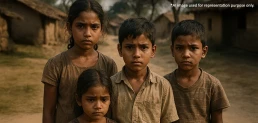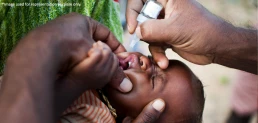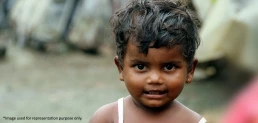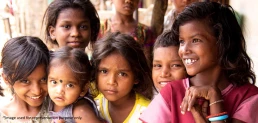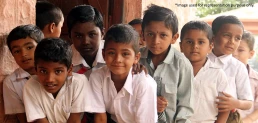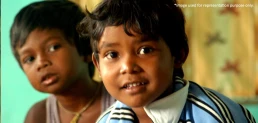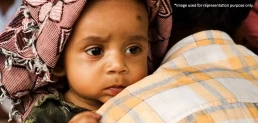Good health starts with the basics of nutritious food and proper hygiene. But for many children in marginalized communities, these essentials are often out of reach. Limited awareness and the inability to afford balanced meals make them more vulnerable to common childhood diseases that hold back their growth and future.
To change this, we need to look at the common diseases affecting children, understand simple yet effective steps to improve nutrition and hygiene, recognize the role parents and communities can play, and see how CRY is working to give every child a healthier tomorrow.


What are the most common diseases of childhood?
Childhood is often marked by frequent illnesses, many of which are preventable with proper care. Some of the most common childhood diseases in India include:
- Respiratory infections (Cold, flu, pneumonia): Children are more prone to catching infections due to their developing immune systems. Poor nutrition and crowded living spaces often worsen these conditions.
- Diarrheal diseases: Caused mainly by unsafe drinking water, poor sanitation, and unhygienic food practices, diarrhea remains one of the leading causes of child mortality worldwide.
- Malnutrition and anemia: Undernutrition, along with deficiencies like lack of iron, severely affects growth, immunity, and learning abilities in children.
- Skin infections: Lack of hygiene and clean surroundings often lead to fungal or bacterial skin issues, including scabies and ringworm.
- Worm infestations: Children in underprivileged communities are particularly vulnerable to intestinal worms due to poor sanitation and contaminated food or water.
Also Read: Vital Role of Nutrition in Protecting Marginalized Children
The role of nutrition in preventing childhood illness
Nutrition is one of the strongest defenses a child has against common diseases of childhood. Let’s understand the nutrient sources and the diseases they resist by building a strong immunity:
- Protecting from colds, flu, and other viral infections: Nutrients like vitamins A, C, and E, along with zinc and iron, play a key role in safeguarding from common flu and other viral infections.
- Protecting from undernutrition and stunted growth: A diet rich in proteins, leafy greens like drumsticks, pulses, fruits, and whole grains ensures children do not fall prey to undernutrition or iron-deficiency anemia.
- Protecting from delay in cognitive growth: Omega-3 fatty acids, iodine, and B vitamins are essential for healthy brain development, concentration, and learning abilities.
- Protecting from severe illness: Even when children do get sick, good nutrition helps their bodies cope better, reducing the severity and duration of illnesses.
How hygiene practices reduce the risk of illness
Nutrition alone cannot ensure a child’s well-being if they are growing up in poor environments with unhygienic habits. Good hygiene is a shield that protects children, especially in communities where medical care may not always be within reach.
- Handwashing with soap: Regularly washing hands before meals and after using the toilet is one of the most effective ways to prevent diarrhea, respiratory infections, and even eye diseases.
- Hygienic sanitation: Proper use of toilets and safe disposal of waste stop harmful bacteria and worms from spreading within communities.
- Menstrual hygiene: For adolescent girls, access to clean sanitary products and knowledge about menstrual hygiene is crucial. Poor menstrual hygiene can lead to infections, discomfort, and even school absenteeism.
- Oral hygiene: Brushing teeth twice a day keeps cavities, gum infections, and bad oral health at bay.
- Safe food practices: Cooking food properly, covering it to avoid contamination, and ensuring clean utensils prevent foodborne illnesses.
- Personal cleanliness: Bathing regularly, wearing clean clothes, and trimming nails help reduce the spread of skin infections and parasites.
Also Read: Let’s Protect Underserved Children From Ill Health
Combining nutrition and hygiene for stronger immunity
Good nutrition and proper hygiene work hand in hand to keep children healthy. While nutritious food strengthens the body from within, hygiene practices prevent harmful germs from causing illness. Together, they form a powerful shield, ensuring children can grow, learn, and thrive in good health.
Role of parents, schools, and communities
No parents or caregivers alone can ensure the best health of children by following the above practices. It is only when parents, schools, and communities come together that happier childhoods can be ensured through collaborative efforts.
- \
- Parents: Provide balanced meals, teach handwashing and personal hygiene, guide girls on menstrual hygiene.
- Schools: Offer nutritious meals, teach health and hygiene, maintain clean toilets and safe drinking water.
- Communities: Organize health camps, sanitation drives, and awareness programs to support children’s well-being.
Also Read: Anemia in Rural Children: A Health Problem We Can’t Ignore
How CRY America is promoting nutrition and hygiene to prevent childhood diseases
- WASH programme: CRY America’s project team conducts Water, Sanitation, and Hygiene (WASH) initiatives with the support of Panchayat leaders and School Management Committees, helping communities understand how simple hygiene practices can protect children from common childhood diseases.
- Filtered drinking water: CRY America’s project team guides communities to use natural, zero-cost methods to purify water at home thus making safe drinking water a part of children’s everyday lives.
- Kitchen gardening practices: The project team encourages families to grow small gardens in their backyards, giving children fresh vegetables and fruits right at home, and turning every meal into a step toward better health.
- Monitoring children’s growth & dietary plans: With the help of Anganwadi workers, CRY America’s project team ensures newborns and infants are registered, vaccinated on time, and their growth carefully tracked, ensuring that no child slips into undernutrition unnoticed.
- Referrals to NRC for severe malnutrition: When a child shows severe signs of malnutrition, our team works with government hospitals and Nutritional Rehab Centers (NRCs) to make sure they get the treatment and care needed for recovery.
- Anemia screening & Iron-Folic Supplementation: CRY America’s project teams organize health camps for adolescent girls, where those found with low haemoglobin are given Iron-Folic tablets to help them regain strength and continue their education without health setbacks.
- Encouraging poultry farming at home: The project team guides families to start small-scale poultry farming, giving children access to protein-rich food and improving the household’s nutrition in a sustainable way.
Conclusion
While we have helped shield millions of children by facilitating access to proper nutrition and hygiene, hundreds still await the nourishment they deserve to begin a healthier, brighter future. Donate now to ensure happier, and healthier childhoods .
Recommended for you











